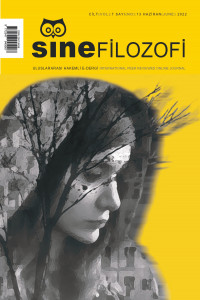‘Nebula’ Filminde Anı-İmge ve Zaman-İmge Olarak ‘Ölü At’
‘Dead Horse’ as Memory-Image and Time-Image in the Film of ‘Dead Horse Nebula’
Author(s): Alper ErçetingözSubject(s): Existentialism, Philosophy of Mind, Present Times (2010 - today), Film / Cinema / Cinematography
Published by: Serdar Öztürk
Keywords: Memory-image; time-image; Henri Bergson; Gilles Deleuze; Dead Horse Nebula;
Summary/Abstract: The way person handles time affects people’s relationship with time. In a fragmented and linear understanding of time consisting of the past, present and future, human lives only the present, in a single moment. When considered as an uninterrupted whole, time is in the form of a flow in which these three phenomena are intertwined. In this form of time, human is in a state of becoming, in which some images of memory can affect a person’s current action by reaching from the past to the present. The concept of time is among the main structural elements of cinema together with space and movement. These concepts activate the mechanisms of perception and thought in cinema as in real life. Drawing attention to the similarity between the functioning of the human mind and the functioning of images in a film, Henri Bergson’s theory of memory and ‘memory-image’ concept, together with Gilles Deleuze’s image theory, which points to cinema as an art of time, address this complex relationship between cinema and time. Tarık Aktaş’s film Nebula (2018), which does not follow a story in the traditional sense, focuses on the daily life of the main character hay, while all the events that take place in the film are clustered around an image of a memory of the past. Time images, which disrupt the linear flow of time and break the rational bond arising from the cause-and-effect relationship between scenes, also make this image visible, which contains a memory of the past. In the study, which is based on the approach that images are ‘readable’ as well as ‘visible’, Bergson and Deleuze’s definitions of memory-image and time-image are questioned by the qualitative content analysis method of the time elements contained in the film.
Journal: SineFilozofi
- Issue Year: 7/2022
- Issue No: 13
- Page Range: 142-155
- Page Count: 14
- Language: Turkish

